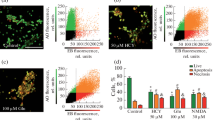Abstract
1. The effects of inorganic Hg2+ and methylmercuric chloride on the ionic currents of cultured hippocampal neurons were studied and compared. We examined the effects of acute exposure to the two forms of mercury on the properties of voltage-activated Ca2+ and Na+ currents and N-methyl-D-aspartate (NMDA)-induced currents.
2. High-voltage activated Ca2+ currents (L type) were inhibited by both compounds at low micromolar concentrations in an irreversible manner. Mercuric chloride was five times as potent as methylmercury in blocking L-channels.
3. Both compounds caused a transient increase in the low-voltage activated (T-type) currents at low concentrations (1 μM) but blocked at higher concentrations and with longer periods of time.
4. Inorganic mercury blockade was partially use dependent, but that by methylmercury was not. There was no effect of exposure of either form of mercury on the I–V characteristics of Ca2+ currents.
5. Na+- and NMDA-induced currents were essentially unaffected by either mercury compound, showing only a delayed nonspecific effect at a time of overall damage of the membrane.
6. We conclude that both mercury compounds show a relatively selective blockade of Ca2+ currents, but inorganic mercury is more potent than methylmercury.
Similar content being viewed by others
REFERENCES
Arakawa, O., Nakahiro, M., and Narahashi, T. (1991). Mercury modulation of GABA-activated chloride channels and non-specific cation channels in rat dorsal root ganglion neurons. Brain Res. 551:58–63.
Atchison, W. D. (1987). Effects of activation of sodium and calcium entry on spontaneous release of acetylcholine induced by methylmercury. J. Pharmacol. Exp. Ther. 241:131–139.
Atchison, W. D. (1988). Effects of neurotoxicants on synaptic transmission: Lessons learned from electrophysiological studies. Neurotoxicol. Teratol. 10:393–416.
Atchison, W. D., Joshi, U., and Thornburg, J. E. (1986). Irreversible suppression of calcium entry into nerve terminals by methylmercury. J. Pharmacol. Exp. Ther. 238:618–624.
Blazka, M. E., and Saikh, Z. A. (1991). Differences in cadmium and mercury uptakes by hepatocytes: role of calcium channels. Toxicol. Appl. Pharmacol. 110:355–363.
Brookes, N., and Kristt, D. A. (1989). Inhibition of amino acid transport and protein synthesis by HgCl2 and methulmercury in astrocytes: selectivity and reversibility. J. Neurochem. 53:1228–1237.
Büsselberg, D., Evans, M. L., and Rahmann, H. (1991). Effects of inorganic and triethyl lead and inorganic mercury on the voltage activated calcium channel of Aplysia neurons. Neurotoxicology 12:733–744.
Büsselberg, D., Evans, M. L., Haas, H. L., and Carpenter, D. O. (1993a). Blockade of mammalian and invertebrate calcium channels by lead. Neurotoxicology 14:249–258.
Büsselberg, D., Platt, B., Haas, H. L., and Carpenter, D. O. (1993b). Voltage-gated calcium channel currents of rat dorsal root ganglion (DRG) cells are blocked by Al3+. Brain Res. 622:163–168.
Carbone, E., and Swandulla, D. (1989). Neuronal calcium channels: Kinetics, blockade and modulation. Prog. Biophys. Mol. Biol. 54:31–58.
Chang, L. W. (1980). Mercury. In Experimental and Clinical Neurotoxicology (P. S. Spencer and H. H. Schaumburg, Eds.) Williams and Wilkins, Baltimore, pp. 508–526.
Doerner, D., Pitler, T. A., and Alger, B. E. (1988). Protein kinase C activators block specific calcium and potassium current components in isolated hippocampal neurons. J. Neurosci. 8:4069–4078.
Fisher, R. E., Gray, R., and Johnston, D. (1990). Properties and distribution of single voltage-gated calcium channels in adult hippocampal neurons. J. Neurophysiol. 64:91–104.
Hughes, W. H. (1957). A physicochemical rationale for the biological activity of mercury and its compounds. Ann. N.Y. Acad. Sci. 65:454–460.
Huguenhard, M., Gutnickm, M. J., and Prince, D. A. (1993). Transient Ca2+-currents in neurons isolated from rat lateral habenula. J. Neurophysiol. 70:158–166.
Juang, M. S. (1976). An electrophysiological study of the action of methylmercury chloride and mercuric chloride on the sciatic nerve-sartorius muscle preparation of the frog. Toxicol. Appl. Pharmacol. 37:339–348.
Manalis, R. S., and Cooper, G. P. (1975). Evoked transmitter release increased by inorganic mercury at frog neuromuscular junction. Nature 257:690–691.
Meyers, D. E., and Barker, J. L. (1989). Whole-cell patch-clamp analysis of voltage-dependent calcium conductances in cultured embryonic rat hippocampal neurons. J. Neurophysiol. 61:467–477.
Mullaney, K. J., Fehm, M. N., Vitarella, D., Wagoner, D. E., and Aschner, M. (1994). The role of-SH groups in methyl mercuric chloride-induced D-aspartate and rubidium release from rat primary astrocyte cultures. Brain Res. 641:1–9.
Oyama, Y., Carpenter, D. O., Ueno, S., Hayashi, H., and Tomiyoshi, F. (1995). Methylmercury induces Ca-dependent hyperpolarization of mouse thymocyte: A flow-cytometric study using fluorescent dyes. Eur. J. Pharmacol. 293:101–107.
Pekel, M., Platt, B., and Büsselberg, D. (1993). Mercury (Hg2+) decreases voltage-gated calcium channel currents in rat DRG and Aplysia neurons. Brain Res. 632:121–126.
Rossi, A. D., Larsson, O., Manzo, L., Orrenius, S., Vahter, M., Berggren, P., and Nicotera, P. (1993). Modulations of Ca2+ signaling by inorganic mercury in PC12 cells. FASEB J. 7:1507–1514.
Takahashi, K., Ueno, S., and Akaike, N. (1991). Kinetic properties of T-type Ca2+ currents in isolated rat hippocampal CA1 pyramidal neurons. J. Neurophysiol. 65:148–155.
Yaari, Y., Hamon, B., and Lux, H. D. (1987). Development of two types of calcium channels in cultured mammalian hippocampal neurons. Science 235:680–682.
Author information
Authors and Affiliations
Rights and permissions
About this article
Cite this article
Szücs, A., Angiello, C., Salánki, J. et al. Effects of Inorganic Mercury and Methylmercury on the Ionic Currents of Cultured Rat Hippocampal Neurons. Cell Mol Neurobiol 17, 273–288 (1997). https://doi.org/10.1023/A:1026338217097
Issue Date:
DOI: https://doi.org/10.1023/A:1026338217097




